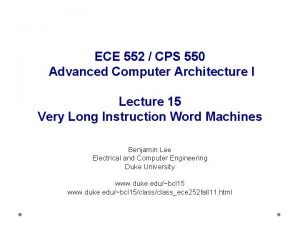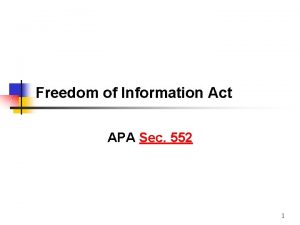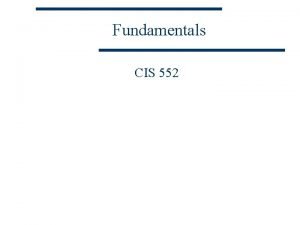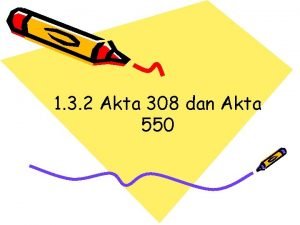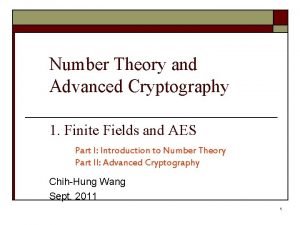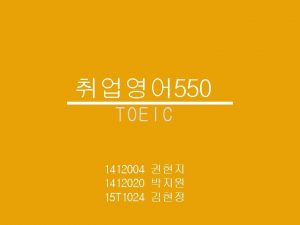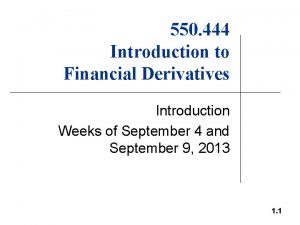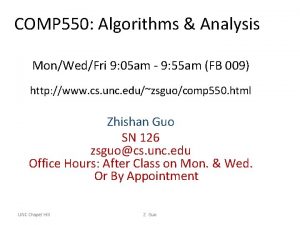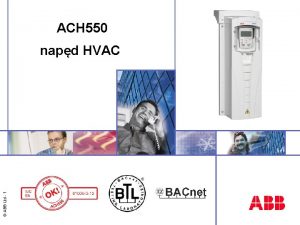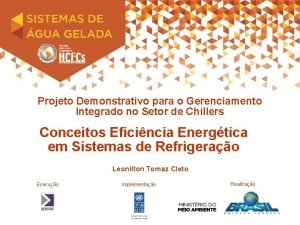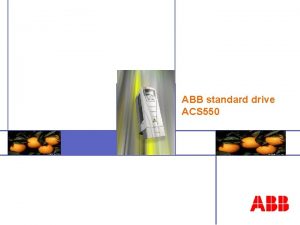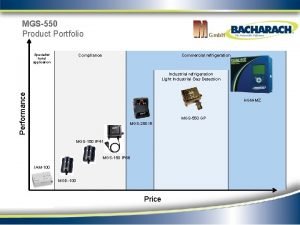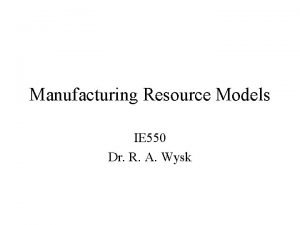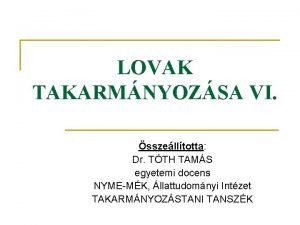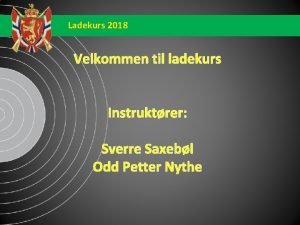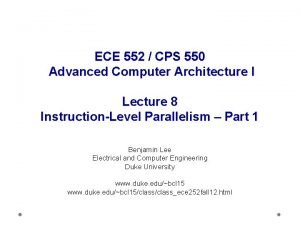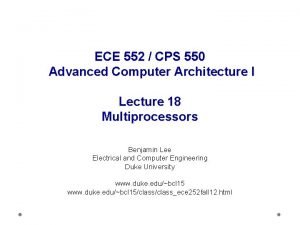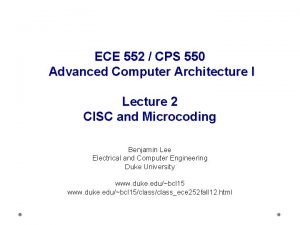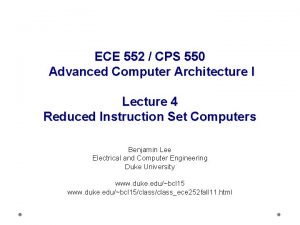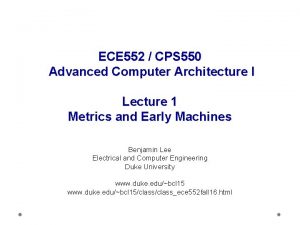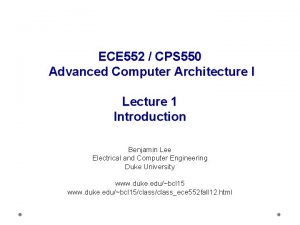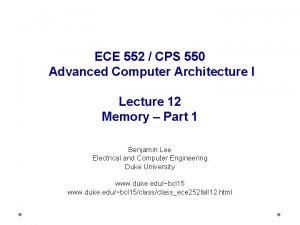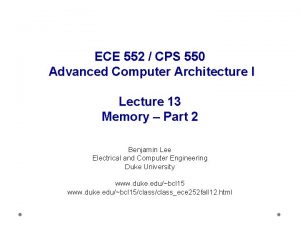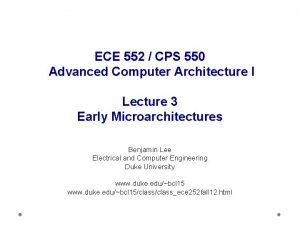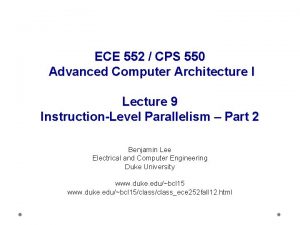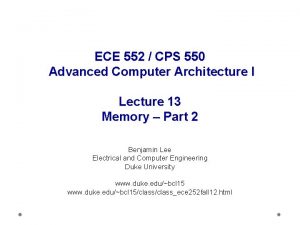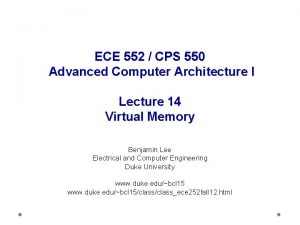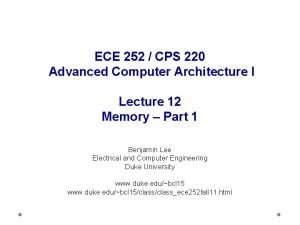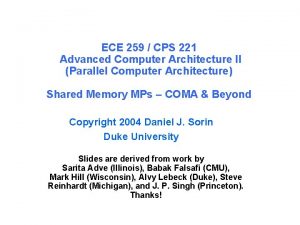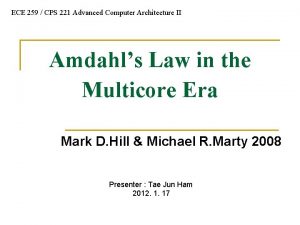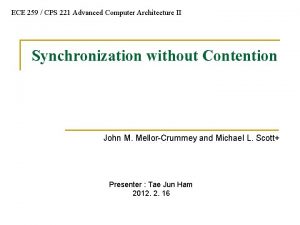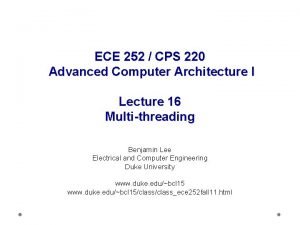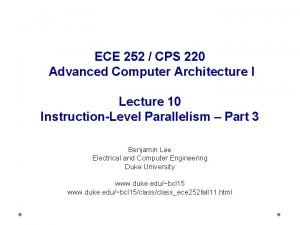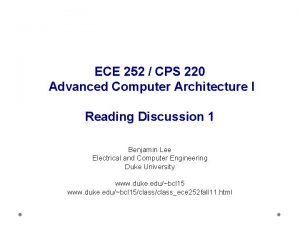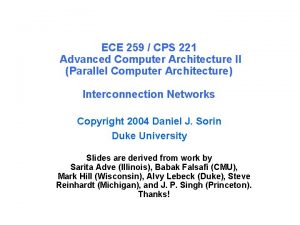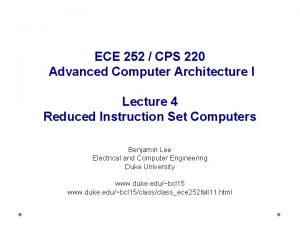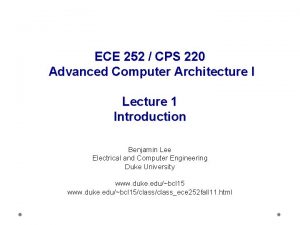ECE 552 CPS 550 Advanced Computer Architecture I


































- Slides: 34

ECE 552 / CPS 550 Advanced Computer Architecture I Lecture 16 Multi-threading Benjamin Lee Electrical and Computer Engineering Duke University www. duke. edu/~bcl 15/class_ece 252 fall 12. html

ECE 552 Administrivia 13 November – Homework #4 Due Project Status - Plan on having preliminary data or infrastructure 8 November – Class Discussion 1. 2. 3. 4. Roughly one reading per class. Do not wait until the day before! Mudge, “Power: A first-class architectural design constraint” Lamport, “How to make a multiprocessor computer that correctly executes multiprocess programs” Lenoski et al. “The Stanford DASH Multiprocessor” Tullsen et al. “Simultaneous multithreading: Maximizing on-chip parallelism” ECE 552 / CPS 550 2

Last Time Out-of-order Superscalar • Hardware complexity increases super-linearly with issue width Very Long Instruction Word (VLIW) • • • Compiler explicitly schedules parallel instructions Simple hardware, complex compiler Later VLIWs added more dynamic interlocks Compiler Analysis • • Use loop unrolling and software pipelining for loops, trace scheduling for more irregular code Static compiler scheduling is difficult in presence of unpredictable branches and variable memory latency ECE 552 / CPS 550 3

Multi-threading Instruction-level Parallelism - Objective: Extract instruction-level parallelism (ILP) Difficulty: Limited ILP from sequential thread of control Multi-threaded Processor - Processor fetches instructions from multiple threads of control If instructions from one thread stalls, issue instructions from other threads Thread-level Parallelism - Thread-level parallelism (TLP) provides independent threads Multi-programming – run multiple, independent, sequential jobs Multi-threading – run single job faster using multiple, parallel threads ECE 552 / CPS 550 4

Increasing Pipeline Utilization In an out-of-order superscalar processor, many apps cannot fully use execution units Consider percentage of issue cycles in which processor is busy. Tullsen, Eggers and Levy. “Simultaneous multi-threading, ” ISCA 1995. ECE 552 / CPS 550 5

Superscalar (In)Efficiency Issue width Instruction issue Completely idle cycle (vertical waste) Time ECE 552 / CPS 550 Partially filled cycle, i. e. , IPC < 4 (horizontal waste) 6

Pipeline Hazards t 0 t 1 t 2 t 3 t 4 t 5 t 6 t 7 t 8 LW LW ADDI SW r 1, 0(r 2) r 5, 12(r 1) r 5, #12 12(r 1), r 5 t 9 t 10 t 11 t 12 t 13 t 14 F D X MW F D D D D X MW F F F F D D Data Dependencies - Dependencies exist between instructions Example: LW-LW (via r 1), LW-ADDI (via r 5), ADDI-SW (via r 5) Solutions - Interlocks stall the pipeline (slow) Forwarding paths (requires hardware, limited applicability) ECE 552 / CPS 550 7

Vertical Multithreading Issue width Instruction issue Second thread interleaved cycle-by-cycle Time Partially filled cycle, i. e. , IPC < 4 (horizontal waste) With cycle-by-cycle interleaving, remove vertical waste ECE 552 / CPS 550 8

Multithreading t 0 t 1 t 2 t 3 t 4 t 5 t 6 t 7 t 8 t 9 T 1: T 2: T 3: T 4: T 1: LW ADD XORI SW LW r 1, 0(r 2) r 7, r 1, r 4 r 5, r 4, #12 0(r 7), r 5, 12(r 1) F D X MW F D X MW Interleave instructions from multiple threads in pipeline - Example: Interleave threads (T 1, T 2, T 3, T 4) in 5 -stage pipeline - For a given thread, earlier instruction writes-back (W) before later instruction reads register file (D). Example: [T 1: LW r 1, 0(r 2)] writes back before [T 1: LW r 5, 12(r 1)] decodes - ECE 552 / CPS 550 9

CDC 6600 Peripheral Processors - Cray (1964) built first multithreaded hardware architecture - Pipeline with 100 ns clock period 10 “virtual” I/O processors provides thread-level parallelism Each virtual processor executes one instruction every 1000 ns (= 1 ms) Minimize processor state with accumulator-based instruction set ECE 552 / CPS 550 10

Simple Multithreaded Pipeline PC PC PC 1 1 1 I$ IR GPR 1 X Y D$ +1 2 Thread select 2 - Additional State: One copy of architected state per thread (e. g. , PC, GPR) Thread Select: Round-robin logic; Propagate thread ID down pipeline to access correct state (e. g. , GPR 1 versus GPR 2) - Software (e. g. , OS) perceives multiple, slower CPUs ECE 552 / CPS 550 11

Multithreading Costs User State (per thread) - Program counters Physical register files System State (per thread) - Page table base register Exception handling registers Overheads and Contention - Threads contend for shared caches, TLB Alternatively, threads require additional cache, TLB capacity Scheduler (OS or HW) manages threads ECE 552 / CPS 550 12

Fine-Grain Multithreading Switch threads at instruction-granularity Fixed Interleave (CDC 6600 PPUs, 1964) - PPU – peripheral processing unit Given N threads, each thread executes one instruction every N cycles Insert pipeline bubble (e. g. , NOP) if thread not ready for its slot Software-controlled Interleave (TI ASC PPUs, 1971) - PPU – peripheral processing unit OS explicitly controls thread interleaving Example: blue thread scheduled 2 x as often as orange, purple thread Why was thread scheduling introduced for peripheral processing units first? ECE 552 / CPS 550 13

Coarse-Grain Multithreading Switch threads on long-latency operation Tera MTA designed for supercomputing applications with large data sets and little locality - Little locality no data cache Many parallel threads needed to hide long memory latency If one thread accesses memory, schedule another thread in its place Other applications may be more cache friendly - Good locality data cache hits Provide small number of threads to hide cache miss penalty If one thread misses cache, schedule another thread in its place ECE 552 / CPS 550 14

Denelcor HEP (1982) First commercial hardware-threading for main CPU - Architected by Burton Smith Multithreading previously used to hide long I/O, memory latencies in PPUs - Up to 8 processors, 10 MHz Clock 120 threads per processor Precursor to Tera MTA ECE 552 / CPS 550 15

Tera MTA (1990) - Up to 256 processors Up to 128 threads per processor - Processors and memories communicate via a 3 D torus interconnect Nodes linked to nearest 6 neighbors - Main memory is flat and shared Flat memory no data cache Memory supports one memory access per cycle per processor Why does this make sense for a multi-threaded machine? ECE 552 / CPS 550 16

MIT Alewife (1990) Anant Agarwal at MIT SPARC - RISC instruction set architecture from Sun Microsystems Alewife modifies SPARC processor Multithreading - ECE 552 / CPS 550 Up to 4 threads per processor Threads switch on cache miss 17

Multithreading & “Simple” Cores IBM Power. PC RS 64 -IV (2000) - RISC instruction set architecture from IBM Implements in-order, quad-issue, 5 -stage pipeline Up to 2 threads per processor Oracle/Sun Niagara Processors (2004 -2009) - Targets datacenter web and database servers. SPARC instruction set architecture from Sun Implements simple, in-order core - Niagara-1 (2004) – 8 cores, 4 threads/core Niagara-2 (2007) – 8 cores, 8 threads/core Niagara-3 (2009) – 16 cores, 8 threads/core ECE 552 / CPS 550 18

Oracle/Sun Niagara-3 (2009) ECE 552 / CPS 550 19

Why Simple Cores? Switch threads on cache miss - If a thread accesses memory, flush pipeline switch to another thread Simple Core Advantages - Minimize flush penalty with short pipeline (4 cycles in 5 -stage pipeline) Reduce energy cost per op (out-of-order execution consumes energy) Simple Core Trade-off - Lower single-thread performance Higher multi-thread performance and energy efficiency ECE 552 / CPS 550 20

Superscalar (In)Efficiency Issue width Instruction issue Completely idle cycle (vertical waste) Time ECE 552 / CPS 550 Partially filled cycle, i. e. , IPC < 4 (horizontal waste) 21

Vertical Multithreading Issue width Instruction issue Second thread interleaved cycle-by-cycle Time Partially filled cycle, i. e. , IPC < 4 (horizontal waste) Vertical multithreading reduces vertical waste with cycle-by-cycle interleaving. However, horizontal waste remains. ECE 552 / CPS 550 22

Chip Multiprocessing (CMP) Issue width Completely idle cycle (vertical waste) Time Partially filled cycle, i. e. , IPC < 4 (horizontal waste) Chip multiprocessing reduces horizontal waste with simple (narrower) cores. However, (1) vertical waste remains and (2) ILP is bounded. ECE 552 / CPS 550 23

Simultaneous Multithreading (SMT) Issue width Time Interleave multi-threaded instructions with no restrictions. Tullsen, Eggers, Levy. University of Washington, 1995. ECE 552 / CPS 550 24

IBM Power 4 IBM Power 5 Power 4 - Single-threaded processor - Out-of-order execution, superscalar (8 execution units) ECE 552 / CPS 550 25

IBM Power 4 IBM Power 5 Power 4 – single-threaded processor, 8 execution units Power 5 – dual-threaded processor, 8 execution units ECE 552 / CPS 550 26

IBM Power 5 Data Flow - Program Counter: duplicate and alternate fetch between two threads - Return Stack: duplicate since different threads call different sub-routines - Instruction Buffer: queue instructions separately - Decode: de-queue instructions depending on thread priority ECE 552 / CPS 550 27

IBM Power 4 IBM Power 5 Support multiple instruction streams - Increase L 1 instruction cache associativity - Increase instruction TLB associativity - Mitigate cache contention from instruction streams - Separate instruction prefetch and buffering per thread - Allow thread prioritization Support more instructions in-flight - Increase the number of physical registers (e. g. , 152 to 240) - Mitigate register renaming bottleneck Support larger cache footprints - Increase L 2 cache size (e. g. , 1. 44 MB to 1. 92 MB) - Increase L 3 cache size - Mitigate cache contention from data footprints Power 5 core is 24% larger than Power 4 core ECE 552 / CPS 550 28

Instruction Scheduling ICOUNT: Schedule thread with fewest instructions in flight (1) prevents one thread from filling issue queue (2) prioritizes threads that efficiently move instructions through datapath (3) provides an even mix of threads, maximizing parallelism ECE 552 / CPS 550 29

SMT Performance Intel Pentium 4 Extreme SMT - Single program - 1. 01 x speedup for SPECint and 1. 07 x speedup for SPECfp - Multiprogram (pairs of SPEC workloads) - 0. 9 -1. 6 x for various pairs IBM Power 5 - Single program - 1. 23 x speedup for SPECint and 1. 16 x speedup for SPECfp - Multiprogram (pairs of SPEC workloads) - 0. 89 -1. 41 x for various pairs Intuition - SPECint has complex control flow, idles processor, benefits from SMT - SPECfp has large data sets, cache conflicts, fewer benefits from SMT ECE 552 / CPS 550 30

SMT Flexibility For SW regions with high thread level parallelism (TLP), share machine width across all threads For SW regions with low thread level parallelism (TLP), reserve machine width for single thread instruction level parallelism (ILP) Issue width Time ECE 552 / CPS 550 Issue width Time 31

Types of Multithreading Time (processor cycle) Superscalar Simultaneous Fine-Grained. Coarse-Grained. Multiprocessing. Multithreading Thread 1 Thread 2 ECE 552 / CPS 550 Thread 3 Thread 4 Thread 5 Idle slot 32

Summary Out-of-order Superscalar • Processor pipeline is under-utilized due to data dependencies Thread-level Parallelism • Independent threads more fully use processor resources Multithreading • • Reduce vertical waste by scheduling threads to hide long latency operations (e. g. , cache misses) Reduce horizontal waste by scheduling threads to more fully use superscalar issue width ECE 552 / CPS 550 33

Acknowledgements These slides contain material developed and copyright by - Arvind (MIT) - Krste Asanovic (MIT/UCB) - Joel Emer (Intel/MIT) - James Hoe (CMU) - Arvind Krishnamurthy (U. Washington) - John Kubiatowicz (UCB) - Alvin Lebeck (Duke) - David Patterson (UCB) - Daniel Sorin (Duke) ECE 552 / CPS 550 34
 Ece552
Ece552 Ece 552
Ece 552 Omd hospital
Omd hospital Resguardos fijos
Resguardos fijos Apa 552
Apa 552 +1 (617) 552-2015
+1 (617) 552-2015 Cis552
Cis552 Cs 552
Cs 552 Fundamentals of cpu in advanced computer architecture
Fundamentals of cpu in advanced computer architecture Three bus architecture
Three bus architecture Architecture and organization difference
Architecture and organization difference What is basic computer organization
What is basic computer organization 603 550 israelites
603 550 israelites Byzantine empire 550 ad
Byzantine empire 550 ad 550 poirier st coquitlam bc
550 poirier st coquitlam bc Akta 550
Akta 550 Dcs 550
Dcs 550 Inverse of 550 in gf(1759)
Inverse of 550 in gf(1759) 900 e yuvarlanan sayılar
900 e yuvarlanan sayılar Toeic 550
Toeic 550 550-444
550-444 550 en romanos
550 en romanos Monwedfri
Monwedfri Ach 550
Ach 550 Ttff puzzle answer
Ttff puzzle answer Ahri
Ahri Gupta sculpture
Gupta sculpture 550
550 550+330
550+330 Telit sat 550
Telit sat 550 Mgs-550
Mgs-550 Ie 550
Ie 550 Tth 550
Tth 550 Billig hylsetrommel
Billig hylsetrommel Reittiopas 550
Reittiopas 550
